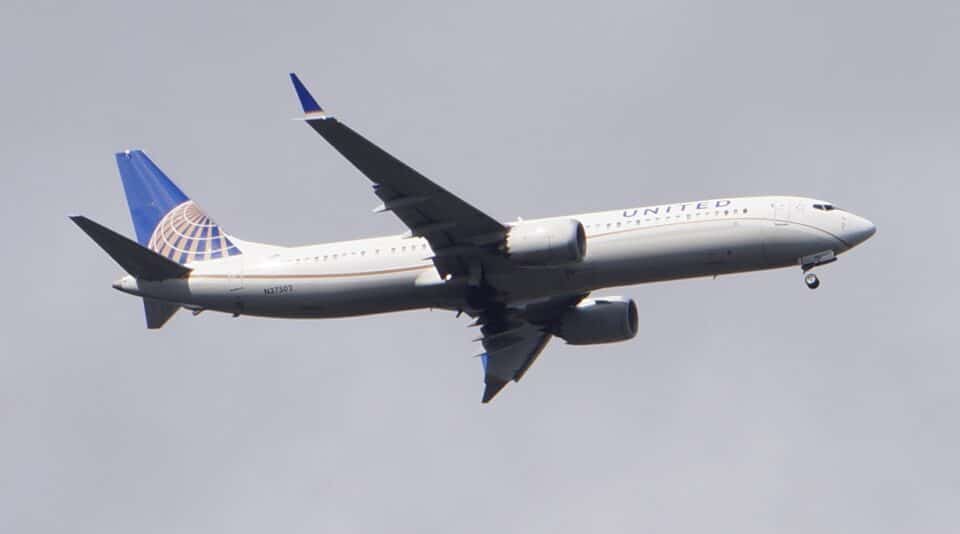Aviation
United Boeing 737 MAX 9 mistakenly landed on RWY 28L rather than 28C at Pittsburgh Airport

The National Transportation Safety Board has launched an investigation to determine how the crew of a United Airlines 737-9 landed on the wrong runway in Pittsburgh last June.
This incident occurred on United Airlines aircraft UA-2627 on June 21st. This service is provided by the airline on a daily basis from Chicago O’Hare International (KORD) in Illinois to Pittsburgh International (KPIT) in Pennsylvania, USA. The flight is usually around an hour long. The flight had 168 passengers and 6 personnel on board on the day of the incident.
Upon initial contact with PIT approach control, the flight crew was told to expect a visual approach to runway 32 into PIT. The flight crew briefed the new approach and proceeded to load the ILS 32 approach into the FMC to back up the visual approach.
While being radar vectored on the downwind and descending through about 4,000 feet Mean Sea level (msl), the flight crew indicated that they had a check landing altitude message displayed briefly on the FMC. After the message disappeared and with the autopilot engaged, the aircraft reverted to control wheel steering pitch mode. They selected level change and reselected the autopilot to command mode.
The airplane began its descent at about 0918 EDT, and as they were descending, approach control asked them if they could accept a visual approach to runway 28C. The weather was clear, and the winds were 250 degrees at 4 knots, so they accepted the runway change. The first officer then re-programmed the FMC for the RNAV GPS Y 28C to back up the visual approach.
The flight crew established communication with the local controller when the airplane was approximately 6. 5 miles east of the airport. They crew advised the controller they were on a visual approach to Runway 28C, to which the controller cleared them to land on Runway 28C. According to the captain, approximately 2 miles from SUPPR, on an intercept heading and while descending, “the screen was black, both FMC’s blanked” except for the aircraft communications, addressing and reporting system (ACARS) prompt and no FMC prompt. The captain used heading select and level change on the mode control panel (MCP). However, when the airplane joined an approximate 6-mile final, it was aligned with Runway 28L.
When the airplane was approximately on a 2-mile final and still aligned with Runway 28L, the flight crew requested verification of their clearance to land on Runway 28C. The controller advised the flight crew of mowing in progress in the grass area and cleared them to land on Runway 28C.
The flight crew read back their clearance to land on Runway 28C.
About 0944 EDT, the airplane landed on runway 28L, turned right off the runway, and exited runway 28L at taxiway F5. The controller noticed the airplane was lined up for runway 28L when it was on short final but decided that it was more appropriate to allow the airplane to land given their altitude. The facility reported that the traffic volume was light with routine complexity. The distance from the airport traffic control tower to the runway 28C threshold was approximately 7,500 feet.
Courtesy : Source

Aviation
Boeing, Antonov to Collaborate on Defense Projects

– MOU represents Boeing’s commitment to work with Ukrainian industry
– Includes exploring opportunities for collaborating on in-country support of Unmanned Aerial Systems
A Memorandum of Understanding was signed today by Boeing and Antonov Company to investigate potential collaboration on defense-related projects.
“We’re happy to keep collaborating with the Antonov Company to help Ukraine’s economic development and expansion,” stated Ted Colbert, CEO and president of Boeing Defence, Space, & Security.
Airbus and the Antonov An-225: The Best Partnership:Click here
“This agreement demonstrates our ongoing efforts to find more opportunities to work with Ukrainian industry, which was underscored by our signing of the Ukrainian Defence Industry Compact earlier this year.”
The areas of potential collaboration identified in the agreement consist of training, logistical support and overhaul services for tactical Unmanned Aerial Systems utilized by the Ukrainian Armed Forces, which includes the ScanEagle. In addition, the companies will also explore opportunities for Antonov to provide engineering support to Boeing.
The six largest cargo aircraft ever built in the aviation industry:Click here
“A strong, innovative, and efficient defense industry is key to sustainable economic development and national security, and we are extremely excited to collaborate with Boeing,” said Ievhen Gavrylov, CEO of Antonov Company.
This agreement brings a whole new level of opportunity to implement the latest and most effective solutions – in addition to the possibility of future projects with Boeing in the aerospace and defense industry.”
-

 Travel1 week ago
Travel1 week agoAir India to Expand US Operations with Three New Routes After a Decade
-

 Travel2 weeks ago
Travel2 weeks agoWhy We Should Avoid These Stamps in a Passport
-

 Airlines1 month ago
Airlines1 month agoInvestigations Reveal Fake Chinese Titanium in Boeing and Airbus Jets
-

 Tech4 weeks ago
Tech4 weeks agoChina’s CATL Plans 1,800-Mile Electric Plane Launch by 2027
-

 Airport3 days ago
Airport3 days agoTop 10 Largest Airports in the World by Size
-

 Aerospace4 weeks ago
Aerospace4 weeks agoChina’s Fighter Jets Turn Wings into Autonomous Drones
-

 Airlines4 days ago
Airlines4 days agoAir India Rolls Out A350s for Delhi-New York JFK and Newark Routes
-

 Defence3 weeks ago
Defence3 weeks agoBoeing Enhances Chinook with New Engines and Block II Upgrades at $96 Million








